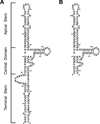Magnesium-dependent interaction of PKR with adenovirus VAI
- PMID: 20713064
- PMCID: PMC2980848
- DOI: 10.1016/j.jmb.2010.08.015
Magnesium-dependent interaction of PKR with adenovirus VAI
Abstract
Protein kinase R (PKR) is an interferon-induced kinase that plays a pivotal role in the innate immunity pathway for defense against viral infection. PKR is activated to undergo autophosphorylation upon binding to RNAs that contain duplex regions. Activated PKR phosphorylates the α-subunit of eukaryotic initiation factor 2, thereby inhibiting protein synthesis in virus-infected cells. Viruses have evolved diverse PKR-inhibitory strategies to evade the antiviral response. Adenovirus encodes virus-associated RNA I (VAI), a highly structured RNA inhibitor that binds PKR but fails to activate. We have characterized the stoichiometry and affinity of PKR binding to define the mechanism of PKR inhibition by VAI. Sedimentation velocity and isothermal titration calorimetry measurements indicate that PKR interactions with VAI are modulated by Mg(2+). Two PKR monomers bind in the absence of Mg(2+), but a single monomer binds in the presence of divalent ion. Known RNA activators of PKR are capable of binding multiple PKR monomers to allow the kinase domains to come into close proximity and thus enhance dimerization. We propose that VAI acts as an inhibitor of PKR because it binds and sequesters a single PKR in the presence of divalent cation.
Copyright © 2010 Elsevier Ltd. All rights reserved.
Figures




Similar articles
-
Domain interactions in adenovirus VAI RNA mediate high-affinity PKR binding.J Mol Biol. 2014 Mar 20;426(6):1285-95. doi: 10.1016/j.jmb.2013.12.019. Epub 2014 Jan 4. J Mol Biol. 2014. PMID: 24394721 Free PMC article.
-
Regulation of Protein Kinase R by Epstein-Barr Virus EBER1 RNA.Biochemistry. 2020 Mar 31;59(12):1252-1260. doi: 10.1021/acs.biochem.0c00088. Epub 2020 Mar 18. Biochemistry. 2020. PMID: 32176479
-
Structural analysis of adenovirus VAI RNA defines the mechanism of inhibition of PKR.Biophys J. 2015 Feb 3;108(3):748-57. doi: 10.1016/j.bpj.2014.12.014. Biophys J. 2015. PMID: 25650941 Free PMC article.
-
Viral proteins targeting host protein kinase R to evade an innate immune response: a mini review.Biotechnol Genet Eng Rev. 2018 Apr;34(1):33-59. doi: 10.1080/02648725.2018.1467151. Epub 2018 May 2. Biotechnol Genet Eng Rev. 2018. PMID: 29716441 Review.
-
The search for a PKR code-differential regulation of protein kinase R activity by diverse RNA and protein regulators.RNA. 2019 May;25(5):539-556. doi: 10.1261/rna.070169.118. Epub 2019 Feb 15. RNA. 2019. PMID: 30770398 Free PMC article. Review.
Cited by
-
Analysis of PKR-RNA interactions by sedimentation velocity.Methods Enzymol. 2011;488:59-79. doi: 10.1016/B978-0-12-381268-1.00003-3. Methods Enzymol. 2011. PMID: 21195224 Free PMC article.
-
The use of analytical sedimentation velocity to extract thermodynamic linkage.Biophys Chem. 2011 Nov;159(1):120-8. doi: 10.1016/j.bpc.2011.05.014. Epub 2011 May 27. Biophys Chem. 2011. PMID: 21703752 Free PMC article.
-
Specificity of the double-stranded RNA-binding domain from the RNA-activated protein kinase PKR for double-stranded RNA: insights from thermodynamics and small-angle X-ray scattering.Biochemistry. 2012 Nov 20;51(46):9312-22. doi: 10.1021/bi300935p. Epub 2012 Nov 9. Biochemistry. 2012. PMID: 23140277 Free PMC article.
-
Activation of PKR by short stem-loop RNAs containing single-stranded arms.RNA. 2016 Jul;22(7):1065-75. doi: 10.1261/rna.053348.115. Epub 2016 May 20. RNA. 2016. PMID: 27208315 Free PMC article.
-
Dissection of the adenoviral VA RNAI central domain structure reveals minimum requirements for RNA-mediated inhibition of PKR.J Biol Chem. 2014 Aug 15;289(33):23233-23245. doi: 10.1074/jbc.M114.550046. Epub 2014 Jun 26. J Biol Chem. 2014. PMID: 24970889 Free PMC article.
References
-
- Toth AM, Zhang P, Das S, George CX, Samuel CE. Interferon action and the double-stranded RNA-dependent enzymes ADAR1 adenosine deaminase and PKR protein kinase. Prog. Nucleic Acid Res. Mol. Biol. 2006;81:369–434. - PubMed
-
- Tian B, Bevilacqua PC, Diegelman-Parente A, Mathews MB. The double-stranded RNA binding motif: Interference and much more. Nature Rev. Mol. Cell Biol. 2004;5:1013–1023. - PubMed
Publication types
MeSH terms
Substances
Grants and funding
LinkOut - more resources
Full Text Sources

